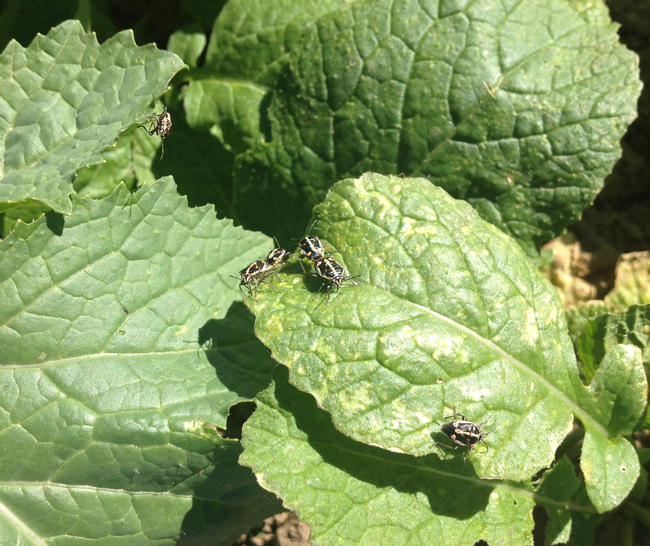Bagrada bug, Bagrada hilaris is an invasive stink bug and is moving North from the Southern Counties of California, rapidly than anticipated. In the past weeks, I have detected huge populations of these stink bugs on Indian mustard (cover crop), broccoli raab and kale in the King City and San Ardo areas. It is more likely that low populations exist in the other parts of the Salinas Valley.
It is well known that bagrada bug prefers cruciferous hosts (Family: Brassicaceae) including broccoli, cauliflower, cabbage, kale, arugula, collards, and Indian mustard. Major crops, lettuce and spinach are NOT a suitable host for bagrada bug. Also, these bugs can survive on cruciferous weeds such as mustard species (Brassica sp), wild radish, London rocket, short pod mustard and shepherd’s purse, as well as the insectary crop sweet asylum or sunflower. Mustard weeds species are very common in the Salinas Valley along ditches, roadsides and even along the edges of agricultural fields. Mustard cover crops such as white mustard (Sinapsis alba) and Indian mustard (Brassica juncea) in particular, could harbor bagrada bug populations which are not often monitored for pests.
Bagrada bug adult could be easily confused with harlequin bug. Adult of harlequin bug is orange with black and white marks, whereas bagrada bug adult is black with orange and white marks; and adult harlequin bug is about 3 times larger than bagrada bug. Eggs of harlequin bug are white with horizontal, black strips, whereas bagrada bug has no strips but has a “dirty” white appearance.
Damage to brassica crops is varied but could be severe. Severe economic loss has been reported when injury occurred during early developmental stages of the crop such as coldyledon or < 4 leaves stages. Injury on leaves appears initially as small puncher marks, which turn into white patches as leaves expand. In broccoli and cauliflower, the economic injury occurs when the bug feeding kills the apical meristematic tissue of young seedling, which later result in “multiple heads” or sometimes “blind heads” (without a head). Severe feeding also depletes the nutrient reserves of the plant leading to desiccation or wilting.
At this time, monitoring for bugs is the key. Monitoring for bagrada bug during mid-day hours might increase the probability of finding them as the bugs typically hide and stay in the cracks and crevices or on the underside of leaves when the temperature is on the cooler side. Cruciferous weeds in the drains, river bottoms, edges of the field or near residential area increase the risk of establishment. Do not forget to check the brassica cover crops for bugs as well.
Based on the insecticide efficacy studies conducted in University of Arizona, bifenthrin and methomyl were most effective in reducing bagrada bug infestation and injury on broccoli. For organic growers, none of the products were efficacious but pyrethrin and azidirachtin are suggested.
If you detect bagrada bug in Monterey, Santa Cruz and San Benito Counties, please do not hesitate to contact me (Shimat Joseph) at svjoseph@ucdavis.edu or (831) 759-7359.
Further reading:
//ucanr.edu/blogs/blogcore/postdetail.cfm?postnum=9023
Video (by Surendra Dara): http://youtu.be/gSj3AZoJIRM

